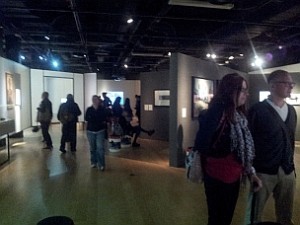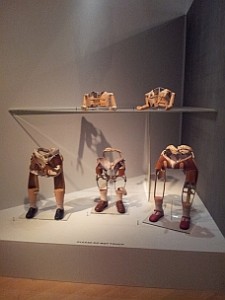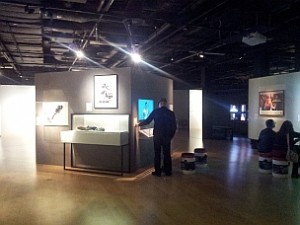I always look forward to Wellcome Collection exhibitions. Not only for their inherent quirkiness and lateral-thinking curation, but because they make for great Future Conscience posts! Okay, so there’s a selfish motivation in there; but really it’s more of an appreciation for the collection and the way the team promotes its breadth and highlights some fascinating aspects of the relationship between humanity and science throughout the ages. The latest exhibition Superhuman: Exploring Human Enhancement from 600 BCE to 2050 is another great offering.
 The first thing I noticed when compared to the previous exhibition Brains: The Mind as Matter was that the layout of the space was much more open and free flowing. There is far less emphasis on glass cabinets, as the exhibition moves away from the fetishisation of objects and creates a contemplative space of imagery and ideas with substantial amounts of film and artistic work.
The first thing I noticed when compared to the previous exhibition Brains: The Mind as Matter was that the layout of the space was much more open and free flowing. There is far less emphasis on glass cabinets, as the exhibition moves away from the fetishisation of objects and creates a contemplative space of imagery and ideas with substantial amounts of film and artistic work.
The interpretation of the topic hinges upon a few dominant themes: broadening the definition of enhancement, including a too-brief look through history; our changing attitudes towards disability; the integration of man and machine; and the world of sport and human athletic endeavour (including the eye-catching colour of vintage superhero comics). Capping these sections off is an open space with a future timeline to 2050 prominently displayed, and a collection of ‘talking head’ experts that explore some of the more detailed areas of philosophical and ethical grappling with the transhumanist themes that are understated but run through the whole exhibition.
Let’s get the obvious part out of the way. As a free exhibition I can do nothing but recommend that you go and see it, and I have the highest praise for the continued efforts of the exhibitions team at the Wellcome Collection. They’ve created another fantastic space right in the heart of London that challenges our perceptions of self and identity and does so in an accessible way. If you’re reading this and are located in London then you should definitely make the time to drop by – it will take an hour out of your day and will plant enough seeds of thought to last you many evenings of conversation and debate (indeed, for some of us, they become a life-long obsession).
Some of the themes that I found most impacting, coming from the position of having already grappled with the futurist themes of transhumanism, are to be found in the first half of the exhibition. To begin with, the broadening of the theme back into the past breaks the commonly held notion that issues of human enhancement are merely an issue for the future. I’d never considered before that high-heels are an example of this train of thought, but of course they are even by the very name they go by. Likewise a substance such as Viagra, enhancing our sexual drive and ability and extending vibrant sexuality until well into old age.
 The sections on disability were impacting and empathetic, with a whole section on the damage caused by widespread use of thalidomide during a four year period between 1958-1962 and the subsequent birth defects that followed. The showing of Matthew Barney’s surrealist film Cremaster 3: The Third Degree filled with esoteric imagery and overt references to Masonic symbolism I found of personal interest, and they were linked to the exhibition by the inclusion of Paralympian and double amputee Aimee Mullins in the film. It was a quote from a 2009 TED talk of hers that opened up a new way of thinking about human augmentation and disability that I hadn’t previously considered:
The sections on disability were impacting and empathetic, with a whole section on the damage caused by widespread use of thalidomide during a four year period between 1958-1962 and the subsequent birth defects that followed. The showing of Matthew Barney’s surrealist film Cremaster 3: The Third Degree filled with esoteric imagery and overt references to Masonic symbolism I found of personal interest, and they were linked to the exhibition by the inclusion of Paralympian and double amputee Aimee Mullins in the film. It was a quote from a 2009 TED talk of hers that opened up a new way of thinking about human augmentation and disability that I hadn’t previously considered:
“The conversation with society has changed profoundly in this last decade. It is no longer a conversation about overcoming deficiency. It’s a conversation about augmentation; it’s a conversation about potential. A prosthetic limb does not represent the need to replace loss anymore. It can stand as a symbol that the wearer has the power to create whatever it is that they want to create in that space, so that people society once considered to be disabled can now become the architects of their own identities…”
When juxtaposed against the films and images of the impact of thalidomide and the resulting effort to produce prosthetics to overcome the birth deficiencies of having no arms or limbs, or the artistic short displaying victims of landmines chasing flying prosthetic legs, suddenly we can see that shift in perception displayed for us in a direct way. We are moving into that period where augmentation is not only about restoring what was lost, but equally or even more so about discovering what is possible. This is the core theme of the exhibition and its scope, and it’s a powerful one.
With this strongest point in mind, where the exhibition falls short surprisingly enough is the question of transhumanism and its impact on our sense of identity. There are pithy lines in some of the interpretation panels that ask questions such as: will we retain our essential humanity if the border between man and machine is completely removed? But they are left hanging, the anxiety is pointed out in passing without leading the viewer into an emotional encounter with what that question really means.
Granted, it’s not an easy thing to do, and the attempt to cover the more weighty issues with the darkened area of talking heads discussing deeper philosophical concepts falls short mainly because it lacks a certain sense of gravity and enthusiasm around the subject. This question is big, it’s not one that can be dealt with easily but it is one that can be opened up creatively and through the kinds of artistic pieces that run throughout the exhibition the viewer could have been left with a much more impacting idea of how central these questions are to our foreseeable future.
 Instead they are relegated to a dark corner, one in which the words of those speaking can’t be heard clearly enough and for most visitors are likely not part of their experience of the exhibition at all. Thankfully the very well produced programme gives their positions in full, and for just £1 you can’t possibly ask for a better piece of the exhibition to take away with you.
Instead they are relegated to a dark corner, one in which the words of those speaking can’t be heard clearly enough and for most visitors are likely not part of their experience of the exhibition at all. Thankfully the very well produced programme gives their positions in full, and for just £1 you can’t possibly ask for a better piece of the exhibition to take away with you.
But there’s still a sense throughout that something is lacking, that the gravitas of the subject is not truly grappled with but rather only lightly approached – perhaps because to envisage it or articulate it in the language of an exhibition of this size proves very difficult to do. Of course, this might also have to do with the scope of the collection itself and you have to work with what you’ve got.
If you get a chance to visit this exhibition in a group I would recommend you do so, the timeline wall – with its various predictions up to 2050 (why do we always stop there…is it because most alive today won’t live past that period?) – is situated in a large open space. One that just begs for a vibrant group discussion about the various markers of future progress that it predicts. The extensive use of artistic thinking and even a large installation piece (I’ll leave you to discover that one, but it’s turned on for an hour a day at 1230 – surprisingly mesmerising) promotes a kind of free-flowing experience that you don’t get in exhibitions that rely more on objects as curiosity items and begs for detailed discussion to go along with it.
This is an exhibition that will make you think and will push the boundaries of how you consider the time period we currently exist in. I just wish that more was done to lead people to a true encounter with the awe-inspiring shift in human identity that we may not necessarily see in our lifetimes, but is almost certainly just around the corner.
Like my previous review, I have to put in here a meek apology for my clandestine photography of the exhibition. I hope that those from the Wellcome Collection will appreciate that I do so to highlight the fantastic work that you do with each exhibition you put on. Thank you and keep up the great work!

![[Review] Superhuman: Exploring Human Enhancement at the Wellcome Collection](https://www.futureconscience.com/wp-content/uploads/2012/09/Superhuman-Exhibition-Photo-125x125.jpg)


![[Review] Brains: The Mind as Matter - Wellcome Collection exhibition Brains QR code](https://www.futureconscience.com/wp-content/uploads/2012/06/BrainsQR1-150x150.jpg)
